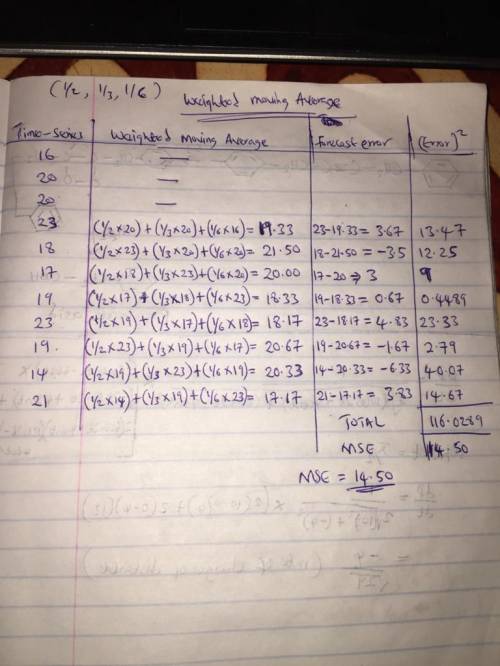
Consider the following gasoline sales time series data. Click on the datafile logo to reference the data.
Week Sales (1000s of gallons)
1 16
2 20
3 20
4 23
5 18
6 17
8 19
9 23
10 19
11 14
12 21
a. Using a weight of 1/2 for the most recent observation, 1/3 for the second most recent observation, and 1/6 the most recent observation, compute a three-week weighted moving average for the time series (to 2 decimals). Enter negative values as negative numbers.
Week
Time-Series Value Weighted Moving
Average Forecast Forecast
Error
(Error)2
1
2
3
4
5
6
7
8
9
10
11
12
Total
b. Compute the MSE for the weighted moving average in part (a).
MSE =
Do you prefer this weighted moving average to the unweighted moving average? Remember that the MSE for the unweighted moving average is 8.90.
Prefer the unweighted moving average here; it has a (greater/smaller) MSE.
c. Suppose you are allowed to choose any weights as long as they sum to 1. Could you always find a set of weights that would make the MSE at least as small for a weighted moving average than for an unweighted moving average? (Yes/ No)

Answers: 1


Another question on Business

Business, 21.06.2019 19:20
You manage an equity fund with an expected risk premium of 10% and a standard deviation of 14%. the rate on treasury bills is 6%. your client chooses to invest $60,000 of her portfolio in your equity fund and $40,000 in a t-bill money market fund. what is the expected return and standard deviation of return on your client’s portfolio?
Answers: 1

Business, 22.06.2019 11:40
Define the marginal rate of substitution between two goods (x and y). if a consumer’s preferences are given by u(x,y) = x3/4y1/4, compute the consumer’s marginal rate of substitution as a function of x and y. calculate the mrs if the consumer has chosen to consumer 48 units of x and 16 units of y. show your work. (use the back of the page if necessary.
Answers: 3

Business, 22.06.2019 12:00
Suppose there are three types of consumers who attend concerts at your university’s performing arts center: students, staff, and faculty. each of these groups has a different willingness to pay for tickets; within each group, willingness to pay is identical. there is a fixed cost of $1,000 to put on a concert, but there are essentially no variable costs. for each concert: i. there are 140 students willing to pay $20. (ii) there are 200 staff members willing to pay $35. (iii) there are 100 faculty members willing to pay $50. a) if the performing arts center can charge only one price, what price should it charge? what are profits at this price? b) if the performing arts center can price discriminate and charge two prices, one for students and another for faculty/staff, what are its profits? c) if the performing arts center can perfectly price discriminate and charge students, staff, and faculty three separate prices, what are its profits?
Answers: 1

Business, 22.06.2019 15:00
Which of the following is least likely to a team solve problems together
Answers: 1
You know the right answer?
Consider the following gasoline sales time series data. Click on the datafile logo to reference the...
Questions



Business, 23.06.2019 00:00

Arts, 23.06.2019 00:00



Mathematics, 23.06.2019 00:00



Physics, 23.06.2019 00:00




Mathematics, 23.06.2019 00:00



Chemistry, 23.06.2019 00:00

Business, 23.06.2019 00:00

Geography, 23.06.2019 00:00





